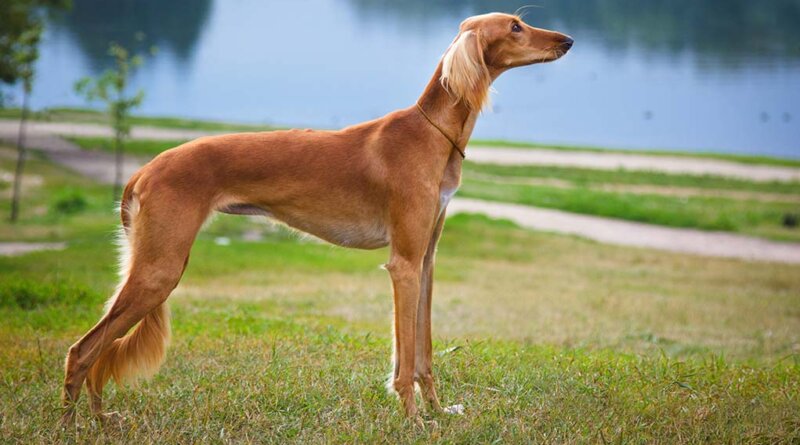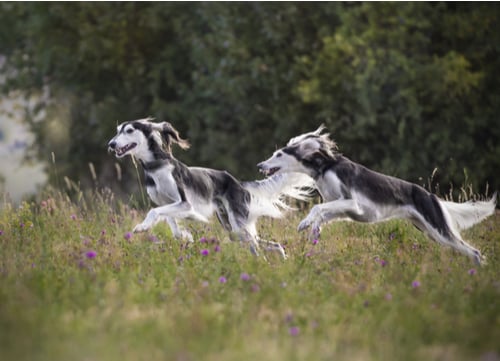All About The Saluki Dog Breed – Top Dog Tips
If you haven’t seen a Saluki or know much about it, we’ve got you covered. This is a guide to the Saluki dog breed and what you need to know. After reading you will be equipped to make a decision if this breed is right for your family.
To start, it looks a bit like a cross between an Afghan hound and a Greyhound. Once you see one, you’ll know exactly what we mean. As one of the most graceful looking dogs, as well as one of the oldest breeds in the world, the Saluki has a lot of interesting history behind it. Here’s a snapshot of the Saluki dog, including their background, appearance, exercise needs, temperament and more.
Saluki Dog Appearance
The Saluki is an elegant-looking, slim dog with long, athletic legs. Their eyes are often hazel colored and oval-shaped, sitting atop their long, narrow head. Their ears are quite long, and some Saluki owners choose to accentuate the look by letting the silky hair on their ears grow, reaching past their shoulders. The same is true of the fur on their long tail, which is often feathered and has a flowy, elegant appearance.
The Saluki’s coat varies in color and sheds very little. Although females tend to be considerably smaller than males, the Saluki dog can reach between 23 – 28 inches high at the shoulders and weigh between 40 – 65 pounds.
Saluki Dog History
The Saluki dog has a rich history. Throughout the years, it has also been called a Persian Greyhound, Gazelle Hound and Arabian Hound. Although it is considered the royal dog of Egypt, it is actually native to Turkey and surrounding regions. It’s name comes from an old Arabian city that no longer exists. Evidence suggests that the Saluki is one of the oldest domesticated dogs in the world. Their bodies were often found mummified with their Pharaoh owners in tombs that also had their pictures inscribed in them.
Historically, Muslims considered Salukis to be sacred gifts from Allah. They were so special that they could not be bought on the market. Instead, you would have to have been given one as a gift of honor or friendship.
The Arabs used Salukis, to hunt gazelle, hare and jackal. This was due to their speed and agility, especially over rough terrain. Considering how fast those creatures are, it provides an idea of just how fast a Saluki could run. When reaching their highest speeds — which can be up to 50 miles per hour — they appear as if they’re floating, with all four legs suspended in the air at the same time.
The American Kennel Club first recognized the Saluki in 1927.
Saluki Dog Temperament
Salukis can make a great pet for the right family. They’re loyal to their owners, but they are also very independent. This roots from their history as an independent hunter, too fast for humans to keep up with. Their independence can make them seem aloof, almost like a cat, but that doesn’t mean they like to be left alone.
Although Salukis are capable of being avid hunters and resilient to desert heat and terrain, that doesn’t mean they don’t like living a luxurious lifestyle. They enjoy soft surfaces to lie on, since they don’t have much body fat to act as natural padding. And although you may find them perfectly happy curled up next to you in bed or on the couch, that doesn’t mean they don’t need physical activity. In fact, the opposite is true. They’re incredibly athletic and need lots of opportunities for physical activity. If they live an active, healthy lifestyle, they can live up to 17 years.
Salukis can be easily distracted and sensitive to harsh discipline. For that reason, some people find them difficult to train. But with any dog, patience is key. Showing them that you’re the pack leader will help them feel more confident and comfortable in their surroundings, which in turn can make them easier to train.
Although Salukis are gentle with kids and even family cats if raised together, it is important to remember that they were bred to hunt small, non-canine animals. For that reason, you should never leave a Saluki unleashed outdoors or in a home with small animals.
The Needs of a Saluki Dog
Salukis are very adaptable and make loyal pets, but they do have specific needs that all owners should be aware of. For example, although you may find them often curled up on a comfy chair in the corner of a room, that doesn’t mean laying around alone is good for them. They are not suited for small apartments and instead need lots of room. This is especially true outdoors, where they need to be able to run. A fenced-in yard is ideal, due to their extreme prey drive.
Exercise
Keeping your Saluki active is key to preventing unwanted behaviors in your home. At a minimum, Salukis need a long-brisk walk daily. However, some Salukis may need much more exercise to keep them happy. They have amazing endurance, so a simple walk is not likely to challenge them much. Instead, running them alongside your bike should get them up to a speed they’re most comfortable with. Don’t overwork them though. A moderate, easy pace on your bike should be enough.
Be prepared if your Saluki sees a small animal while you’re running or biking with them. Without training them to leave the animal alone, you could find that they end up pulling you through the fields in whatever direction the animal is going. And since they’re sighthounds, they may be so focused on keeping their prey in view that they ignore any verbal cues you’re giving them. Remember that this is in their nature and they’re not doing it intentionally to be a bad dog. When possible, choose locations and environments where distractions from small animals are kept to a minimum.
Health Concerns
As for health conditions, the Saluki is prone to some genetic eye diseases, as well as cancer. Special care should be taken in the sun, as the position of their nose on their face makes it prone to sunburn.
Grooming
Grooming is easy with the Saluki. It is odor-free and has a generally short coat over most of its body. Just be sure to brush it weekly. It may need more brushing the more feathering it has, however.
With the proper care and a lifestyle that matches, you might find that you’re an ideal owner for this amazing dog.






